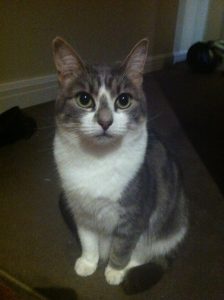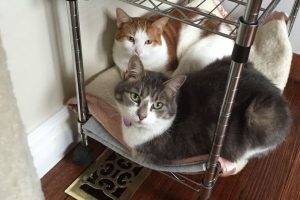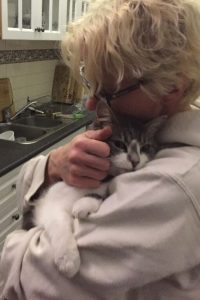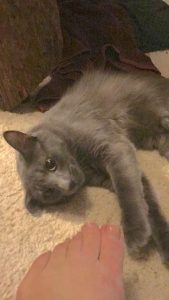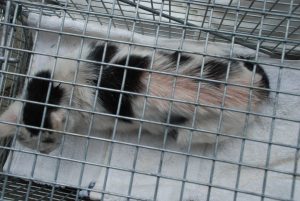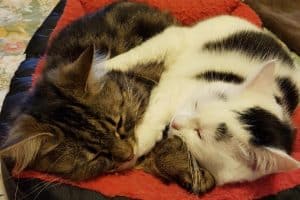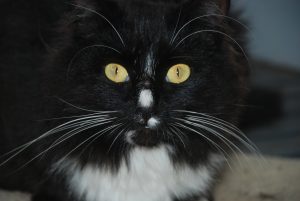
Read others’ experiences about taming feral cats scaredy cats, from when they thought it was impossible, to when their cat went on to be adopted (sometimes by them!).
There are two words we commonly hear from people who tame cats: incredibly rewarding.
“This has been the most rewarding thing ever and beyond anything I thought. It’s amazing!” Gabrielle, wildlife carer
If you have a story you’d like to share, please email us.
On this page
- You’ll never tame her – Isabelle and Natasha
- The smoochiest cat I’ve ever known – Jasper and Megan
- A baptism of fire, then a near house fire – Hudson and Meg
- Cruelty in one state leads to kindness in another – Alexa and Darlene
- Meanwhile, in America – Carol and her garden cats
- A hard nut to crack – Rupert and Lee
- From a public toilet to a beach house – Ghiwa and Jenny
‘You’ll never tame her’
A hissing and spitting machine
Everyone advised me against it
‘You’ll never tame her’, they said.
‘It will take years’, they said.
‘Just take her kittens and surrender her elsewhere’, they said.
But if I don’t help, she’ll be killed
Welcome, Isabelle
She and I do the hard yards
Taking things step by step
The day she came out to eat in my presence. The day she took food from my hand.
The day, and I remember it well, when she rubbed her face on mine. I cried. A momentous progression for us both.
She learns, I learn
A beloved member of the family
All she wants is a home
The rewards are immeasurable
The road has been long and, at times, ridiculously bumpy. There have been many scratches along the way, but they do not outweigh how much I have learnt to love this beautiful girl. She has accepted me. It’s always been on her terms and that is perfectly fine with me.
If you ever get the chance to assist in taming a stray cat, PLEASE, give it a go. It is without doubt the most rewarding experience. At times, it seems all consuming, but the rewards will outweigh any inconveniences a thousand times times over.
I am so glad I took that call one hot December’s day. I am so glad I acted on that call. I am so glad to share my life with my companion,
I will never let her go. And I would do it all again
Natasha
The smoochiest cat
Jasper (one of Isabelle’s’ kittens) is now officially the smoochiest cat I have ever come across. He started with hissing and spitting and never coming near me and in just a few weeks he let down his guard. It has been one of the most rewarding experiences of my life and I would recommend it to anyone.
Megan (Jasper and Megan now live in New Zealand)
A baptism of fire, then a near house fire
Being hissed and spat at wasn’t quite what I had in mind when I offered to foster a cat, but that was my introduction to Hudson – a large, frightened community cat from inner Melbourne.
Hudson had been rescued with his 23 feline friends, and was brought into foster care. Up to this point, the most human contact he had ever experienced was being fed once a day in a local lady’s house. He’d never been touched by anyone. He’d never been held. And everything new was very frightening for him.
It was rough going at first, especially when he’d swipe at me. But I knew it was due to fear, not aggression. I kept telling him that he was in a great place now.
One day, he ate in front of me. Then he gradually started to take food from my hand.
Fast forward to today
Now, you wouldn’t know he was the same cat! He’s the self-appointed head of the household, ruling over four felines, three rowdy dogs and three doting humans. He makes sure everything is just so.
He will lie on me when I’m in the study. He jumps on the bed to be near me, bunts his head in my chin, purrs and occasionally enjoys a belly rub. He and our Kelpie cross adore each other!
He saved my life
Why is this foster cat still with us, you ask? Because Hudson saved my life from an impending house fire!
I was very sick in bed with the flu. He kept jumping on and off me until I eventually roused. I could smell smoke, and Hudson led me into the kitchen. I had accidentally turned the stove element on. The wooden board on top of it was moments away from setting the kitchen alight.
On that eventful day, the person who rescued Hudson and his 23 friends joked, “What more does a cat have to do to get adopted?”
My mind was made up. I was his human and we were his family.
I feel so privileged to have watched Hudson grow and become a relaxed house cat.
Timid cats are awesome cats. They just need a bit more time to learn to trust you. Please consider making one a part of your life. They may well save it!
Meg
From cruelty in one state to kindness in another

A golf course might be a pleasant place for a cat to live but, sadly, this wasn’t Alexa’s experience. Golfers at a Sydney golf course were being cruel to her, so she was trapped and brought into foster care to protect her from them. Having fear instilled in her by their cruelty, she was then ‘too wild’ for the rescue group’s carers to handle.
The lady who ran the rescue organisation knew I had experience with timid cats and asked if I’d help Alexa, which I gladly did. After all, scared cats, timid cats, semi ‘feral’ cats and ‘feral’ kittens are my passion.
Even though I live in another state, Alexa was transported to me and her journey experiencing human kindness, rather than cruelty, began.
For three months, she was quite aggressive, but I could see it was solely fear-based. Her experience of humans until now hadn’t been great – why would she think I would be any different? Then, one day, things ‘clicked’ in her mind. She realised that I wasn’t like those cruel people. All I wanted to do was love her.
I am on a mission to share the joy and beauty of cats such as Alexa who need that added bit of assistance in reaching their full potential. I feel like so many carers are missing out on an experience that, to me, is the absolute definition of cat rescue and rehabilitation.
Darlene and Alexa
Meanwhile, in America
In the beginning…

Buddy and Jazzie – a true bromance
Inch by inch, they got closer
Spoon feeding
Gerbers Chicken with Chicken Gravy baby food was particularly tempting. I would put it on a long wooden spoon and reach out so they could lick it without being terribly close to me. Over time, I brought it in closer and closer until they were eating it from my fingers.
We also played a lot with wand toys which they absolutely delighted in. Every now and then, I would sneak in a very quick pet, which at first they clearly didn’t like. But I kept at it.
After six months, spontaneous affection
And then, what seemed to occur spontaneously (if one could call anything spontaneous after 6 months!), they came in for pets – lots of pets! Now when I come out with food, I am barraged by rubs against my legs, upright tails, and kitties prancing and rolling over everywhere. Some will now sit on my lap.

Peanut – now a lapcat
I still have a few who are in the earlier stages of trust, but I continue to see progress with them.

Peanut and his Mum, Snaps, on Carol’s lap
You can do it too
Please give it a shot. It just takes patience, breaking down your goals into much smaller steps, and a lot of repetition.
I truly believe these cats know where love and safety lies. The payoff is incredible.
Carol
A hard nut to crack

Rupert was a big, muscly, ginger tom and found himself in a crisis situation – he had to leave his previous home, a warehouse, urgently. We were asked if we’d foster him, as we had a bit of experience working with frightened cats.
But we’d never worked with a cat who was quite as frightened as Rupert.
Go away!
He stared intently at us with still, unblinking eyes. He hissed. He spat. He swiped at us with claws outstretched. And, if we pushed him too far, we had absolutely no doubt that his fear was so strong that he might very likely sink his teeth into our hand, in a last ditch effort to make us go away.
Cleaning his litter tray and putting his food and water in was nerve wracking, as we had to dodge his claws and lunges.
Necessity is the mother of all inventions
So we came up with extra precautions to keep ourselves safe while we helped reduce his terror.
Instead of a soft igloo, we used a large carrier as his hiding space in the crate, lined with a heated bed, with the carrier door attached. When we needed to put our hand into his crate, we used a garden stake to push the front of the carrier against the crate, so he couldn’t lash out.
When he was willing to eat in front of us, instead of feeding him with our hand, we used a stick. We’d put his food on a garden stake, then feed it through the crate wire. It worked! He would eat from it. We were safe and he could see that we were the bringer of food.
Would he accept hands?
We made up a ‘taming wand’ and fed that through the wire as well, so we could stroke him and get him used to being touched. At first, he seemed shocked– what’s this touch thing? He would hit the wand. But, over time, you could see him relax – he’d stop staring, he’d fold his arms under his body, he’d look away and he’d close his eyes in contentment. We were so happy to see him feeling less frightened.
He wouldn’t
If we took it extremely slowly (we’re talking 10 to 20 minutes, here, or at least it felt like it), we could work our way down the taming wand until we were stroking him with our hand. Rupert and I had an unwritten agreement – I would make no sudden movements and be very gentle; he would look away and pretend he wasn’t letting himself be touched by a human.
To touch him with our hand and feel his soft fur was, well, incredible. It took our breath away and we were overjoyed. Then we had a drink to calm our nerves.

As with most timid cats, Rupert got on really well with other cats and clearly wanted to interact with them, so we’d put other cats in his crate so he could have play and social time with them. He had two favourite friends who he loved snuggling with.
May I sleep with you?
Despite our best efforts, Rupert never came to enjoy being touched with our hand when he was in the crate. We’d not experienced this before and wondered if being in a room might make a difference.
So we let him out into a sanctuary room – our bedroom. He *loved* playing with other cats. It was the most beautiful sight to see this frightened cat relax, be himself and trill with happiness.
We couldn’t believe it when he jumped on our bed to sleep. We looked in amazement, held our breath and didn’t move a muscle. There were many other beds in the room. This fearful cat was *choosing* to be near us, *choosing* to trust us (in his own way), *choosing* to risk harm from a large human. We felt so very honoured and humbled.
Hands are still not accepted
We continued working with him in the bedroom using a wand, which he loved. But still, our hands were too frightening for him and he would hiss and lean back if he thought we were going to touch him. What had happened to him in the past, we wondered? Was he so frightened because of bad things people had done to him, or was he just ‘hard wired’ to be fearful? Only Rupert knows the answer.
We give him the keys to the house
Still wary of our hands, we decided to let him out into the rest of the house to see if being ‘free’ made any difference to his fear. It didn’t. However, he was very happy hanging out with other cats, exploring the house and being himself.
As we’d never ‘failed’ in socialising a cat before, we had a vet behaviourist come over to meet him. She said something really interesting – that a cat’s fear is passed on from their parents, hard wired in their genes. Maybe Rupert was a tenth generation unsocialised cat and got a severe dose of ‘don’t trust humans’ genes.
She suggested just letting him be, so we did.
Today, he is sanctuaried
Today, Rupert is ‘sanctuaried’ in our home. He’s happy for us to sit right next to him, and look at him lovingly from just a foot away, as long as we don’t try to stroke him with our hand – it has to be with a wand. He loves sleeping with other cats. And he loves having meals on tap.
If things were a bit more progressive in Australia, after desexing, Rupert could perhaps have been returned to his original outside home in an industrial area, the home he knew, where he could keep to himself and live his life without needing to be close to humans or expected to be a companion cat. But Australia hasn’t fully embraced that option, yet.
We’ve often wondered if Rupert would be happier as a working cat or barn cat, doing his own Rupert things with someone providing food for him. But a behaviourist suggested that he will have lost his ‘smarts’ and could be vulnerable to other animals. This was a particular concern as he’s incredibly submissive to other cats – even friendly ones. He’s always the last to eat and never rocks the boat. So much for being a tough guy.
Plus, being a working cat would mean no more heated cat beds – a cat-astrophe!
Unless we find someone who feels touched by Rupert’s story and courage, we’ve accepted that he will probably never be adopted as a companion cat.
And that’s OK. He is himself. He is safe. He has cat friends. And he is loved.
A morning run turns a cat’s life around
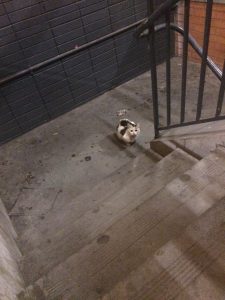

I’m a runner. A marathon runner, actually. It was on one of my daily training runs before work that my life, and that of a cat, changed, for the better.
As I ran through a supermarket carpark one dark and stormy morning, a small white flash scooted in front of me, slipping on the wet gutter, and quickly disappeared into the dirty, disused underground public toilets. It was a kitten-cat who, despite my efforts, remained out of reach amongst the filth in the stairwell.
Over the next three months, I tried unsuccessfully to get authorities’ help to capture and rehome ‘the cat’. For some perverse reason, the long wait, and each new twist and disappointment of failed rescue attempts, only served to make me more determined to ensure ‘the cat’ ended up with a very nice life.
The cat had other ideas
‘The cat’ outwitted the Council and they gave me their blessing to catch them myself. If they weren’t microchipped, I could adopt them.
I sought help from a rescue group which connected me with Scaredy Cats. Thankfully, they were as determined as I was to help ‘the cat’ and, in the early hours of a Sunday morning, rescue of the by now famous ‘Coles Kitty’ finally happened.
She smelt, she was dirty and she was flea-ridden
Her white fur was stained brown by the rubbish in which she lived. She stank to high heaven. And she had been so badly ravaged by fleas that the skin on her back was red. They, too, had adopted the filthy toilet as their home.
Her fur was coarse – more like a dog’s than a cat’s. Perhaps the foul taste of her fur meant that she couldn’t stomach grooming.
Now that she was safe, it was time to give ‘the cat’ a name. I named her Ghiwa, after the supermarket employee who had fed her each night for many months, and who helped us catch her. I then set about convincing her that life with me would be better than life in the toilet.
A cat in a dog crate
I started her off in a XXL wire dog crate and kept a detailed record of each significant event in an Excel sheet – the day she started grooming herself now that she no longer stunk; the day she purred when I offered treats; the day she miaowed at me.
I was chuffed when she let me pat her – and ate roast chicken! – while my Dad was in the room.
The breakthroughs begin
Week 5 and she started making big breakthroughs. She’d greet me at the front of the crate and seek pats without food bribes. She graciously endured a second vet visit and the staff were delighted with her transformation from ‘feral’ to ‘timid’. In a momentous step, at the end of Week 5, she left the crate and explored the spare bedroom. I kept the crate in that room so that she had her familiar ‘safe place’, but it wasn’t long before she stopped using it.
She adored playing with me, so much so that I had to plan play time around my schedule. She was like the Energizer Bunny – she would play on, and on, and on, and on. I taught her to come to me when I called.
My house rules go out the window
By Week 6, it was official – I was no longer the boss of my house. Ghiwa had claimed the (former) spare bed and my ‘no animals on the furniture’ policy had been completely disregarded!! And I didn’t have the heart to do anything about it.
Week 8 came around and she had let me pick her up while I sat or kneeled. Any day now, she and my dog, Bonnie, would meet, and the rest of the house could become her home.
And now, weekends at my beach house
Ghiwa continued making progress and, today, she and Bonnie regularly come with me for weekends away at my beach house.
I recently adopted a three month old kitten, Winnie, so Ghiwa has a friend who ‘speaks her language’. Like Ghiwa, I socialised Winnie from scratch, using the by now familiar method of crate taming before moving her into a sanctuary room.
Five months later
Five months later, Ghiwa and Winnie are best friends. They sleep together, play together and groom each other.
I have recently enclosed one side of my house so that they can have some safe outside time. They love it. And I love it that they love each other.
I often run past the toilet that was Ghiwa’s home and think how much her life has changed. She is a gentle and beautiful cat and I am delighted to have her.
Jenny
^ Top
